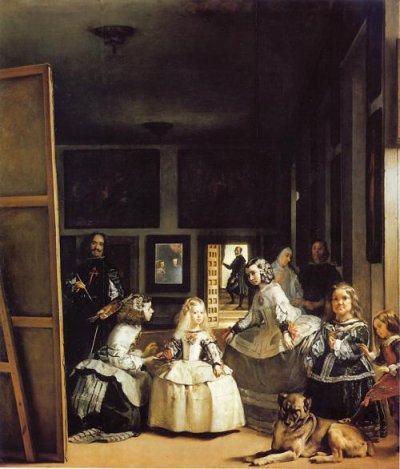
Las Meninas
Las Meninas (1656) is Velasquez’ masterpiece. It is also his most complicated composition but was apparently achieved very quickly without his usual after-thoughts. The paint is remarkably thin, with little over-painting and applied with his usual breadth of handling. Surprisingly out of character for a painter aged fifty six. It needs some explanation. I explained it very simply in an article in The Artist Magazine (Mar 1980) and in a lecture at the Slade at about that time. I also exhibited the model with which I reconstructed the method in the Consort Gallery, Imperial College in that year.
RECONSTRUCTION On the left we see Velasquez at his canvas. A painted self-portrait also often includes the back of the canvas we are looking at, the only difference between this and the usual canvas is that this canvas is very tall. Las Meninas is 10ft, 3.18m tall. A self-portrait requires a mirror. All the other figures appear to be observed in the same mirror. It is surely worth asking the question did Velasquez actually use a mirror. R.Willenski asked that question, and answered yes, but no other art historian seems to have paid the slightest attention. I was initially stimulated to make my own inquiry by reviewing a book “Velasquez. The Art of Painting” devoted to this work, by M.Millner Kahn. Her explanation is so long and tortuous I cannot summarize a whole book.
I agree with Willenski; there are eight good reasons for doing so
1. X-rays show that Velasquez first painted himself as a left-hander and later changed it to conform with reality.
2. He painted the Infanta in the same year but with her parting on the other side of her head. (another mirror reversal)
3. The light comes from the window on the right, it hits the people on the right directly as you would expect but for the Infanta and the people on the left there is also a “fill light” that has bounced off the mirror. See how it illuminates the back of the canvas although the canvas is slanted to receive direct light on the front. Note the cast shadow on the floor.) The mirror is the picture plane between us and the picture. It allows Velasquez to arrange his models within the framed picture space as a photographer might do.
4. All the players look as if they are admiring the Infanta’s reflection in the mirror. The mirror is now at ground level, this may be the first time the Infanta has seen herself in it.
5. The size of the images in the painting are compatible with the idea that Velasquez actually traced their outline on the mirror surface, which he then transferred to his canvas. This would go a long way towards explaining the speed and sureness of the painting’s execution.
6. Velasquez previous work does not suggest an interest in geometric construction or defined interiors, rather the opposite.
7. Until recent times this painting was always exhibited opposite a mirror!
8. Do you see the blob of paint beside the Infanta’s nostril? That confirms the existence of the horizontal support bar we see on the back of the canvas. As the loaded brush hits this ridge it deposits more paint.
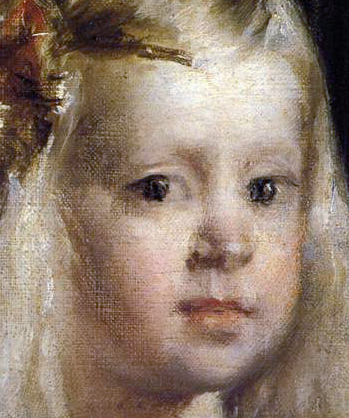
Infanta Margarita
I have been looking at Martin Kemp’s explanation of this painting in “The Science of Art” (Yale, 1990) . Kemp draws a ground plan that does not remotely resemble the room we see. It is far too long and narrow (it cannot even contain the width of the canvas he draws). He does not explain the method but tells us that Velasquez’ painting is “a declaration of his supreme gifts as a magician of painterly illusion”. I identified the room as the Pieza Ocbavada, which was more or less square in ground plan (the near ceiling fixture is its real centre; the other fixture is faked.). This room was next door to the Hall of Mirrors. It is no coincidence, in my view, that Velasquez was occupied with the redecoration of the Hall of Mirrors at the time he painted Las Meninas. It seems highly likely that he moved the great mirror next door to save it from possible damage and there conceived the idea of making a picture of the same size to hang opposite it. It may even be that the Infanta and her entourage composed themselves to some extent in front of this marvel (probably the largest composite mirror the world had ever known: over 8ft wide but lost in the fire of 1734)
It is a long established rule in science that the simplest explanation is likely to be the correct one. Why is it that art historians prefer explanations that are so complicated that they have only the vaguest idea of how they could work. Certainly both the hypotheses mentioned above would tie most practicing painters in knots.
My explanation ( Willenski never pursued the idea) could be very useful to a painter who had a complex group portrait to do. There is every reason to believe that both Goya and Velasquez’ assistant knew and used the method as does Ken Howard in our own day.
CREDITING GENIUS WITH THE IMPOSSIBLE obviously appeals to the earthlings longing for the miraculous. Like Velasquez’ “magician’s” achievement here, Kemp’s preferred methods for Brunelleschi’s invention of modern perspective are all beyond explanation, only his least favourite – (f) in his appendix, can produce the goods. This easy acceptance of the miraculous is a consistent failing of Art Historians. Kemp’s preferred solutions show he does not even grasp the problem and therefore cannot recognize the solution. They all put the cart before the horse: the geometry before the image. His scorned solution(f) does work, so would Hockney’s solution but Hockney has not read Manetti.(see “Brunelleschi’s Perspective” in this blog)
After the publication of my entirely practical explanation of Rembrandt’s quirky production as a draughtsman (Burlington Feb. 1977) which corroborated the reports of Rembrandt’s contemporaries (that he was an inspired observer not an inventor) I visited both Harvard and Yale in search of a publisher for my book on Rembrandt. At Harvard I lectured to the Rembrandt specialists (professors and post-graduate students) The result was a storm of questions. I heard afterwards (at Smith) that the Harvard gang admired my footwork in answering.
AN EXAMPLE
HG “In the 17th c they did not even need still-life in front of them to paint from.”
NK “ What makes you think that”
HG “ Flower painters often painted blooms together that were not in season together”
NK “well flowers wilt, flower painters tend to pick and paint their specimens one at a time”
HG stunned silence.
Although the majority of the audience, I presume, went on to teach and publish on Rembrandt I never received any further communication from any. At the reception afterwards the only people present were myself and the student in charge of the wine. He valiantly tried to convert me to the Harvard view, which has deteriorated still further since then.(see review of the Getty catalogue.)
At Yale I was able to discuss my findings with Prof. Haverkamp Begermann for well over an hour during which time he was unable to advance a single objection to my view. Optimistically I left the typescript of my book with him. After a year, I inquired of it’s progress and it was returned with the accompanying letter which contains the hilarious idea that I had discovered the three dimensional nature of the 17thC imagination! He advised me to write a book about that!
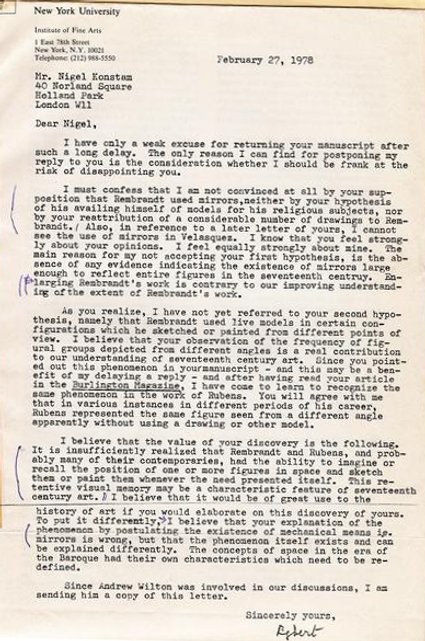
This kind of "thinking" has all but destroyed Rembrandt, the patron saint of the art of observation. Is it not time to wake up to the reality of Art History?
Later, my agents packaged the book on the understanding that it had been accepted by Phaidon with the whole editorial behind it, though they fully understood the revolutionary nature of the contents. All they needed was a reader’s report. When that came they dropped the project and ran. I was given an edited version of the report which made my hair stand on end on the first reading but on closer examination it turned out to be a cunningly crafted swindle. I answered the swindle but to no avail. Word got round and none of the nearly 30 publishers approached after Phaidon found the courage to take on the book but doubtless many experts got a chance for a good look at it. Lawrence Gowing in his review of Svetlana Alpers’ “Rembrandt’s Enterprise” (TLS Dec 16 ‘88) chided “more discussion of the sculptor Nigel Konstam’s observations on Rembrandt’s use of enactments and reflections would not have been out of place”!
Since those days I have done my best to propagate the true Rembrandt with three news-sheets “The Save Rembrandt Campaigner”(to counter the three exhibitions of Rembrandt and his Workshop, in Berlin, Amsterdam and London) with films, shows and DVDs, a website www.saveRembrandt.org.uk and this blog. Most of what I have to say is well within the competence of an educated person. It needs no specialist training in art. All you need is the confidence in your own common sense to see through the bullshit from on high. Our visual culture will be stuck in the mire until some group can muster the momentum to push over the deceitful house-of-cards that is art history. My single voice has all too easily been left to cry in the wilderness.
All these examples can be seen and discussed at
THE MUSEUM OF ARTISTS’ SECRETS.A catalogue of the museum could be of great interest, as also the book on Rembrandt.
Centro d’Arte Verrocchio,
via San Michele 16,
Casole d’Elsa
53031 SI, Italy.
appointments tel.no.0039-0577-948312 or email nkonstam@verrocchio.co.uk
PLEASE PRINT OUT THIS NOTICE FOR THE ART HISTORY NOTICE-BOARD OR OTHER SUITABLE PLACES
For the latest news on Brunelleschi's Perspective and Las Meninas see www.verrocchio.co.uk/nkonstam/blog
Ephebo
This is a secret that has been kept for 2500 years so it is bound to shock.
The great classical tradition of ancient Greece is based on life-casting. I was shocked myself when I discovered this but the proof is beyond dispute as far as I am concerned. It is an unpalatable truth that we must learn to swallow or our culture is founded on a lie.
About the year 500 BC Greek sculpture took a great leap forward, up till that point it had been a provincial imitation of of a culture that had thrived in Egypt for more than 2000 years, reaching its zenith in about 1250 BC in the reigns of Akenaton and Tutunkarmon. The Greeks took the Egyptian tradition a huge step forward towards a more natural pose. The stiffly “at attention” pose gradually softened into the famous Greek contraposto. The Egyptians probably also stood around like this but they never used it in their art. The contraposto so favoured by us was not right for the Egyptians. So it was left to the Greeks to make this break-through. This boy by the sculptor Kritios is the most likely to have been the first. Clearly he is not an athlete, a warrior or a god but an Ephebo, the love object of a homosexual patron, who wanted his boy, to the very life. My guess is that he was first cast in bronze but like 99% of Greek bronzes it was melted down by conquering barbarians to make armaments. This stone version remains more by luck than judgment. It was more valuable as a sculpture than as lime which was all it could have become if destroyed.
This Ephebo may well have been the first body to be cast from life. The drive towards nature was therefore motivated by love.
How can I be so sure? The evidence is very simple. When one models a standing figure in clay one does nothing about the soles of the feet; one cannot see them, no one else will see them. A bronze derived from a clay figure is a hollow shell with no soles (3) but the few surviving life-size bronzes of the classical era all have perfectly formed and naturalistic toes (2) furthermore they are under the pressure of the figures weight. This could only be achieved by the model standing in a pool of fresh plaster (1) When the plaster has set, the rest of the mould is built upon this base. When you think of it the development of Greek sculpture between 500 BC and 450 was far too rapid. It simply is not possible that so many could have reached this perfection so quickly.
These sculptures have become the ideal towards which most figurative sculpture strives. No one has equaled the Greeks. To us casting from life would be considered cheating. For the Greeks it may have been the obvious means of achieving a bronze figure. It would save no end of trouble. They did work over the wax to disguise their method and smarten the result.
Here is the bottom of the foot of one of the Bronzes of Riace. Here is a cast from life that I made myself. I have marked off the hole that would have been cut in the wax to allow the core to be supported. My book will fill in the details and also show the remains of two massive chimneys, one in Athens and the other in Olympia, that I discovered at the same time. The book tells the story of the discoveries.
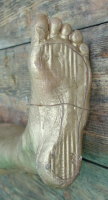 1.) Modern Life Cast - the model was standing on a ridged tile in a pool of plaster.Note the pressure of the model's weight on the soles of the feet |
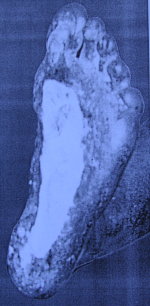 2.) Riace - Perfectly formed and naturalistic toes |
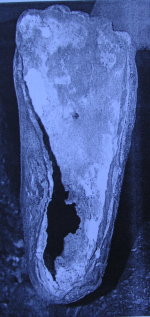 3.) Modern - a hollow shell with no soles |
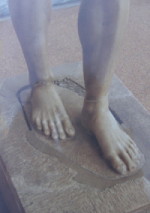 4.) Carved Greek Feet: Pre-life-casting, archaic feet with unnaturally straight small toes and tendons visible when they would normally be sunk in flesh of the foot in this position |
Sculpture the Art and the Practice (2nd edition) ISBN 0-9523568-1-3
I apologize for not answering my critics sooner, I have only just become aware of them. Allow me to explain my point of view more fully on Serota.
Our way of life is changing more rapidly than ever before. Art has to change as life changes. But the white-hot revolution which Harold Wilson (once Prime Minister) foresaw as a great leap forward in opportunities for leisure has in fact put a great deal more stress into human existence; life has speeded up rather than slowed down. Advances in medicine have certainly prolonged life expectancy with the result that the care of the aged now requires far more expense than the pension funds can stand, so pensionable age has to go up. The world population explosion is upon us much sooner than Malthus foresaw. The human population is overwhelming all other species and the planet’s ecology. Climate change etc. etc.
I mention these very real challenges to point out that it is not that easy to predict the future. Yet in art we have allowed Serota with no particular qualifications to dictate the course of art. His “challenging art” does not remotely correspond to life’s challenges as I see them. On the contrary his “cutting edge” is an absurd diversion from what we should be focusing upon.
I see art as an education in seeing what is out there. The more one observes the more one becomes aware of the mental obstacles to seeing. Our survival as a species depends more on the sense of sight than on any other. Serota and his team live in a world of fantasy that does not amuse, it frightens me.
He is a great propagandist but then so were the Nazis, who proclaimed that if you are going to lie, make it a big one. Serota has learnt that lesson well. (see The Jackdaw). He has initiated the most disgraceful episode in the history of art, anywhere. I want to stop him in his tracks. Unfortunately there are a lot of people making a lot of money temporarily out of this financial bubble, so instead of seeing the disgrace, the art establishment is considered a success!
“New Humanism” is my answer to what has gone wrong with art. I respect the Stickists for what they have done to bring about change but I long for a different direction of change, one in which observation figures big again.
Currently there are two theories as to how Brunelleschi arrived at his rules of perspective, which deserve consideration but with which I cannot agree. David Hockney has demonstrated that Brunelleschi could have used a lens to throw the image of the Baptistery onto a surface on which it could then be traced. I could accept this theory if it were not for the evidence of Manetti, a friend of Brunelleschi’s, who had “held the painting (of the Baptistery) in his hands and seen it many times”. I have a second objection to Prof. Martin Kemps preferred theory (he actually lists six possibilities, Hockney’s was published after his book and was therefore not included). The second is that Kemp does not seem to take into account that there were many versions of perspective available at the time; and Brunellschi had to make a second demonstration to persuade people that his was the best.
Giotto and the ancients had a pragmatic means of conveying the space in a building or furniture based on it’s appearance. Ambrogio Lorenzetti and Simone Martini refined this perspective around 1330 so that their complete picture space was logical, and Kemp suggests that this perspective was used by Brunelleschi’s friend, Donatello as late as 1417 in his St. George relief, that is after Brunelleschi had made his first demonstration with the Baptistery. The new perspective did not reach Siena till the 1450s! Clearly the first demonstration was too complicated to follow, or perhaps it smacked too much of wizardry, with its use of two mirrors.
The solution that Kemp least favours I proposed in a lecture at the Slade c1978. (I do not suppose that I was the first to propose it) that is that Brunelleschi’s first demonstration was painted on a “a burnished silver” mirror. Manetti’s description says that “Filippo put burnished silver in the sky” but the reason he gives for this strange behaviour “so that the clouds would be seen to be moved by the winds that blow” seems scarcely credible for a man of Brunelleschi’s scientific bent. It diverts attention from the point he is making. I suggest that the Baptistery and surrounds were painted over the silver but Brunelleschi left the sky unpainted to explain his method.
Brunelleschi had to start from an image of reality that no one could question. The mirror image was such an image. The use of silver as the mirror is easily explained: Brunelleschi was a goldsmith, polished silver was the best reflector available and it had the further advantage over glass that one could scribe on its surface very precisely. The reflective surface could be touched without the thickness of glass intervening. Kemps main objection to this “simple” solution is that ones own image would blot out most of the Baptistery but this is not so. Once one has fixed the eye-point and the mirror one is free to move, to use either eye, and to look through the eye-piece with one’s head at what ever angle is convenient. By this method the size of the blot is no bigger than 2 cm in diameter, that is the distance between the pupil of the eye and the outer skull as reflected. This would not have been the slightest impediment as it need not blot out the outer corners of the Baptistery which are necessary points to fix the image. We can be certain that Brunelleschi would not have gone further with the work before analysing the geometry. The paint would have only been applied to clarify the image for others to appreciate how very like it was to the original. Naturally it needed to be turned round the right way this is why the peep-hole and second mirror were introduced. This method is not only the simplest as Kemp admits, it fits Manetti’s description in all but the one particular. Neither Kemp nor Manetti seem to have understood the need for the second mirror in righting the reversed image traced on the silver mirror.
Kemp’s further objections were:-
-
that Manetti could not have been mistaken in thinking that the silver was applied to the sky area only. But clearly if the rest had been painted over why should he not have made this mistake. On the one occasion on which he held it in his hand we may presume he was preoccupied with seeing the image in the second mirror.
-
Kemp goes on – it does not justify Manetti’s claim for Brunelleschi’s geometry. But it does of course require analytical geometry to arrive at the rules of perspective from the scribed image.
-
The second of Brunelleschi’s demonstrations did not require mirrors; adds Kemp. No, that was why it’s straightforwardness finally convinced the doubters. It was presumably arrived at through the perspective geometry derived from the first demonstration.
(see “A Documentary History of Art vol.I.p171-2 . Anchor books 1957 for Manetti’s whole text in English)
Casole has just become a major art centre. Our excellent museum has mounted an exhibition of true world class. The church has always housed the splendid standing monument to Il Porrina (1305). Always admired but only recently attributed to Marco Romano, a sculptor hardly known before now. This exhibition should certainly put him on the map. Apart from Il Porrina, there is a small head of a prophet, an Annunciation from the high altar of St. Marks (Venice) and a Crucifix, all of outstanding merit.
He is believed to have worked under Giovanni Pisano at Siena. Four plaster casts taken from figures in the Cathedral are displayed as Romano’s early work. By the time he got to Casole (via the Cathedral at Cremona) he was a very different artist. Like Lorenzo Maitani of Orvieto*, Romano turned away from the extreme stylization of of Pisano towards a more natural humanism. Indeed it may well be that Romano brought back the Roman influence to Sienese sculpture that was first introduced by Giovanni’s father Nicola, on the pulpit (c1265). Certainly his work in Siena has a classical flavour.
To make the case for Romano as a distinct, individual voice in sculpture Alessandro Bagnoli has assembled a mind boggling collection of works from as far afield as Berlin, Venice, Florence and Siena: such illustrious names as Giovanni Pisano, Tino da Camaino and Simone Martini are to be seen here in Casole. This show lays the foundations for a larger concurrent show in Santa Maria della Scala, (Siena) of later Sienese work “From Jacopo della Quercia to Donatello”. Both constitute a “must” for students of Sienese sculpture.
*Lorenzo Maitani was Sienese and would have been a contemporary of Romano’s if he ever worked on the Cathedral there. His work takes the same humanist road as Romano’s, I hope to extend my film about Maitani to include works of Marco Romano. We are righting art history here at Casole!